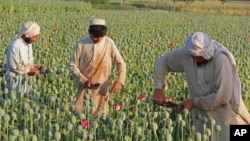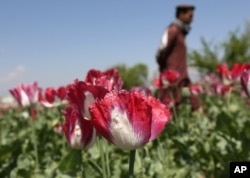Afghanistan, the world’s largest producer of opium, has harvested a record crop this year that more than doubled last year’s production, a bad omen for fighting terrorism and organized crime, officials say.
Salamt Azimi, the country’s minister for counter-narcotics, told VOA's Pashto service that insecurity kept the government from implementing poppy eradication programs, leading to a 64 percent jump in land dedicated to the lucrative crop to 340,000 hectares.
Analysts like Azimi’s predecessor, General Khody Dad Hazara, said corruption and weakness of the government were contributing factors to what he called the country’s drug-fueled “tsunami” disaster.
Shift in tactics
In fighting insurgents, the Afghan government has shifted tactics this year to focus on protecting heavily populated areas. With the Taliban and other extremist groups bolstering their efforts to destabilize the administration, they have managed to seize more land and produce more opium to fund their push.
Last year, poppies were cultivated on 201,000 hectares, yielding 4,700 tons of opium, up 46 percent from 2015. Sources told VOA's Pashto service more than 10,000 tons of opium were produced this year. Opium then can be refined into heroin.
The U.N. Office on Drugs and Crime estimated that opium accounted for some 16 percent of the country’s Gross Domestic Product last year, including more than two-thirds of the entire agricultural sector. In addition to fueling insecurity, violence and insurgency, the drug production is discouraging private and public investment, a UNODC report said.
Afghanistan’s opium production plunged in 2001 after the Taliban-led government banned it. But it jumped back to pre-ban levels - and higher - after the U.S. led invasion of the country late that year. The U.S. has spent billions of dollars trying to quell the problem by encouraging farmers to raise other crops.
Taliban protection
U.S. anti-drug officials say the Taliban provides protection to traffickers in exchange for weapons, funding and other support. A single kilogram of heroin can generate approximately $1.5 million by the time it reaches users, and the U.S. is trying to cope with a rise in addiction to opiates, both prescription drugs and illegally produced drugs like heroin.
That leads to opportunities to bribe police, judges and customs officials, feeding Afghanistan’s endemic corruption and scaring off foreign investment.
“The main threat to the success of the war (on terrorism) is corruption,” John Sopko, who heads corruption watchdog Special Inspector General for Afghanistan Reconstruction (SIGAR), the watchdog for the $113 billion that the U.S. has given the country, said earlier this year.
President Ashraf Ghani warned, years before he became the country’s leader, that Afghanistan had the potential to become a narco-terrorist state.
This story originated in VOA's Deewa Service.







